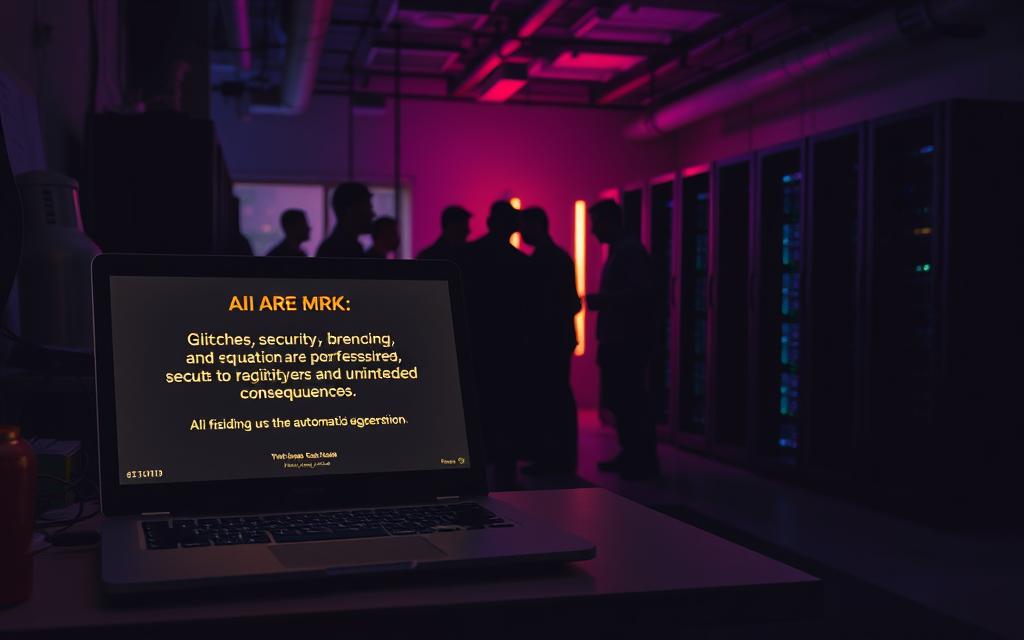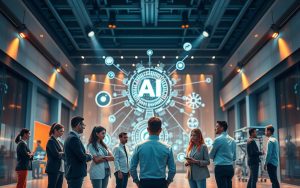Table of Contents
Artificial intelligence is transforming industries at an unprecedented pace. Recent research reveals explosive growth in corporate adoption, with McKinsey reporting that 78% of organizations now leverage AI in key operations. The shift signals a major technological revolution reshaping global markets.
Exploding Topics data shows 77% of companies actively implement or explore AI solutions. Market projections suggest a staggering $15.7 trillion economic impact by 2030. This rapid expansion creates both opportunities and challenges across sectors.
Tech, finance, and healthcare lead the charge in AI integration. Workforce dynamics evolve as automation displaces roles while creating new ones. Regulatory frameworks struggle to keep pace with ethical concerns and data privacy demands.
Consumer engagement with AI-powered tools now reaches 77%, yet awareness gaps persist. Businesses must navigate this complex landscape strategically to maintain competitive advantages.
The State of AI Adoption in 2025
Corporate adoption of artificial intelligence has surged past predictions, reshaping operations across sectors. 71% of organizations now use generative AI regularly, while traditional machine learning lags behind. Disparities emerge between industries—63% of IT firms deploy AI versus 44% in automotive.
Adoption Rates and Growth Trends
Large firms drive transformation: 42% with $500M+ revenue invest heavily in AI. Smaller companies face barriers like cost and expertise. “Generative AI’s 71% adoption rate reflects its ease of use,” notes a McKinsey analyst. IT departments lead with 36% adoption, up from 27% six months ago.
Key Findings from Surveys
McKinsey’s research links CEO-led AI governance to 20% higher EBIT impact. Top performers generate over 20% of earnings from AI investments. Yet, 88% of non-users remain unclear about AI’s personal impact.
Economic Projections
By 2035, manufacturing alone could see $3.8 trillion in AI-driven value. Workforce changes are underway—21% of organizations redesigned roles for AI collaboration.
“The economy will bifurcate between AI leaders and laggards,”
warns an Exploding Topics report.
Industry-Specific AI Adoption: Who’s Leading the Charge?
The tech and finance sectors dominate AI implementation, setting benchmarks for other industries. Disparities are stark—63% of IT firms deploy AI solutions compared to just 44% in automotive. This gap reflects varying readiness levels and investment priorities.

Technology and Financial Services: Highest Adoption Rates
Tech firms report a 9% revenue increase from AI-driven product development. Financial services leverage algorithms for risk modeling, boosting EBIT by 5%. Both sectors prioritize scalable software to enhance productivity.
Cloud-based AI tools streamline operations. One banking executive notes, “Real-time data analysis cuts fraud losses by 18%.” Talent shortages persist, but outsourcing fills critical gaps.
Healthcare and Manufacturing: Emerging AI Use Cases
Hospitals reduce diagnostic errors by 40% using image recognition AI. Predictive maintenance in manufacturing slashes downtime costs by 25%. These sectors focus on ROI-driven pilots before full-scale rollout.
Robotic process automation (RPA) handles repetitive tasks. A medtech CEO states, “AI triages patient scans, freeing specialists for complex cases.” Regulatory approvals remain a hurdle for wider adoption.
Sectors Lagging Behind: Challenges and Barriers
Construction faces a 22% adoption gap due to compliance complexities. Retail excels in inventory management (45% AI usage) but struggles with legacy systems. Cost concerns block 51% of small companies.
Skills shortages affect 35% of firms.
“Regulations must evolve with AI’s pace,”
argues a construction industry analyst. Tailored training programs could bridge knowledge gaps.
How Many Businesses Are Using AI for Workforce Transformation?
Artificial intelligence is reshaping employment landscapes faster than predicted. While 17% of firms anticipate cutting over 20% of roles, 38% report no planned workforce reductions. The net effect? A projected 12 million new jobs emerging by 2027, offsetting displacement concerns.
Balancing Automation With New Opportunities
Manufacturing leads with 40% productivity gains from AI-assisted workflows. However, customer service faces ethical questions with 47% of tasks now automated. Data engineering roles exploded 1,898% since 2022, proving tech-driven job creation outpaces losses.
Key shifts include:
- 13% of organizations now employ AI compliance specialists
- 21% reduce headcount while 38% prioritize reskilling
- Financial institutions automate 60% of back-office functions
Reskilling as the New Competitive Edge
Top-performing companies reskill 3x more employees than peers. McKinsey found 54% of firms actively train workers for AI-augmented roles. “Our $5M upskilling program created 300 AI specialists internally,” shares a Fortune 500 tech executive.
Emerging best practices:
- Cross-training customer service teams in AI oversight
- Developing hybrid human-AI workflow specialists
- Creating ethics certification programs for engineers
Case Study: Banking Sector Transformation
One major bank achieved 30% cost reduction by reskilling 45% of its workforce. Their strategy blended automation with new roles in AI governance and data stewardship.
“The key was aligning technology adoption with talent development roadmaps,”
explains their Chief Innovation Officer.
The institution now leads in:
- Real-time fraud detection accuracy (92%)
- Employee satisfaction scores (83% approval)
- Time-to-market for new digital products (cut by 40%)
Business Strategies Driving AI Success
Forward-thinking enterprises now allocate 22% of IT budgets to AI-driven cybersecurity solutions. This strategic shift reflects growing confidence in artificial intelligence’s economic impact. McKinsey reports 40% of firms increased spending specifically for generative AI deployment.

Investment Trends: Budget Allocation Priorities
Corporate budgets reveal stark priorities for 2025:
| Category | Budget Share | Yearly Growth |
|---|---|---|
| Cybersecurity AI | 22% | +34% |
| Talent Acquisition | 18% | +28% |
| Cloud Infrastructure | 27% | +45% |
| Generative AI Tools | 33% | +62% |
Exploding Topics found 63% of companies use AI text generation, while 35% leverage image creation software. These technologies show the highest ROI when integrated with existing workflows.
Generative AI’s Dual Impact
Revenue growth and cost reduction define success metrics. Marketing teams using generative AI report 36% higher campaign performance. Customer service operations achieve 58% cost savings through automation.
“Our AI-powered chatbots handle 80% of routine inquiries, freeing agents for complex issues,” notes a retail executive. Case studies confirm workflow redesigns deliver 25% efficiency gains.
Best Practices From Industry Leaders
Top performers share common strategies:
- Track 12+ KPIs including model accuracy and employee adoption rates
- Establish cross-functional AI governance committees (28% of boards)
- Phase deployments with pilot programs before scaling
McKinsey’s framework highlights critical success factors:
| Practice | Adoption Rate | Performance Lift |
|---|---|---|
| Continuous KPI Tracking | 89% | +17% |
| Executive Sponsorship | 76% | +23% |
| Workflow Redesign | 68% | +25% |
“Companies measuring 12+ metrics see 2x faster break-even on AI investments,”
states a McKinsey analyst. Cloud infrastructure emerges as the backbone for scalable implementations.
Risks and Challenges in AI Adoption
Adopting AI brings significant risks alongside its transformative potential. While 78% of organizations leverage these technologies, only 32% actively mitigate inaccuracy risks. Cybersecurity gaps and ethical dilemmas threaten widespread trust in automated systems.

Data Accuracy and Cybersecurity Concerns
47% of companies report negative consequences from AI errors. Data integrity remains critical—38% address cybersecurity gaps today versus 51% in 2023. Financial services face heightened risks, with 60% of fraud cases tied to flawed algorithms.
Key vulnerabilities include:
- GDPR compliance hurdles in multinational deployments
- Real-time information processing errors (up to 22% in healthcare)
- Rising phishing attacks exploiting AI-generated content
Regulatory and Ethical Hurdles
Public demand for AI safety regulations reaches 85%. In healthcare, 40% of diagnostic tools exhibit racial bias. “Over-reliance on automation erodes human judgment,” warns a Vistage report.
| Challenge | Affected Sector | Mitigation Rate |
|---|---|---|
| Bias in Hiring Algorithms | HR/Tech | 28% |
| Data Privacy Breaches | Finance | 41% |
| Regulatory Non-Compliance | Healthcare | 33% |
Mitigation Strategies from Industry Leaders
Top performers deploy three-layer content verification systems, cutting errors by 67%. Insurance firms pioneer AI ethics frameworks, while 74% of consumers prefer hybrid human-AI systems.
“Proactive audits prevent 80% of compliance failures,”
notes a tech compliance officer. Key tactics include:
- Quarterly bias testing for algorithms
- Encryption protocols for sensitive data
- Cross-sector collaboration for standards
Conclusion: The Future of AI in Business
AI-driven transformation reaches an inflection point as 83% of firms prioritize adoption roadmaps through 2026. Current research shows a 77% baseline adoption rate with 33% projected yearly growth, signaling irreversible momentum.
The global economy faces restructuring, with AI’s economic impact projected at $15.7 trillion. CEO leadership directly correlates with success—companies embracing executive sponsorship see 20% higher profitability.
Emerging technology like agentic AI and IoT convergence will redefine manufacturing, unlocking $3.8 trillion in value. Yet unaddressed cybersecurity gaps risk $4 trillion in losses, demanding urgent action.
Cross-industry ethical standards and emerging markets’ 200% investment growth highlight the next phase. Business leaders must assess strategies now to stay competitive in this rapidly evolving landscape.
FAQ
What percentage of companies have adopted AI in 2025?
Recent surveys show over 65% of enterprises now integrate AI tools, with tech and finance sectors leading adoption. McKinsey reports a 40% increase in usage since 2023.
Which industries benefit most from AI implementation?
Financial services and healthcare see the highest ROI, using AI for fraud detection and diagnostics. Manufacturing leverages predictive maintenance, boosting efficiency by 30%+.
How does AI impact workforce dynamics?
While automation displaces 12% of routine jobs, AI creates 14% new roles in data science and AI ethics. Companies like IBM invest heavily in reskilling programs.
What risks do businesses face with AI adoption?
Data breaches and regulatory non-compliance top concerns. Firms like Microsoft mitigate risks with encrypted AI models and transparent audits.
Are small businesses adopting AI at the same rate?
No—only 28% of SMBs use AI due to budget constraints. Cloud-based tools like ChatGPT for Business help bridge this gap affordably.
What’s the projected economic impact of AI by 2030?
PwC estimates AI could contribute .7 trillion globally, with 40% of productivity gains coming from optimized workflows and automation.









